Dilbat
Coordinates: 32 ° 9 ′ 0 ″ N , 44 ° 30 ′ 0 ″ E
Dilbat (now Tell ed-Duleym ) was a small Sumerian town southeast of Babylon on the eastern bank of the Euphrates . In the city center stood the ziggurat of Uraš , an earth goddess who was also mentioned in the Gilgameš epic .
The founding of Dilbat falls in the second phase of the early dynasty , around 2700 BC. The settlement was then at least in the time of the empire of Akkad , large parts of the second millennium BC. Inhabited in the Sassanid and early Islamic times. Dilbat was particularly important as a production site for agricultural products, especially wheat.
The site consists of two tells , the western one containing the remains from the first millennium BC and later and a larger eastern one consisting of the remains of earlier eras. Excavations initially took place under the direction of Hormuzd Rassam , who among other things discovered some clay tablets with Neo-Babylonian script. In the late 1980s, the University of Chicago Oriental Institute was working in Dilbat. Today Dilbat is best known for its clay tablets, which are found in illegal robbery excavations that are still taking place and which are put on the black market.
